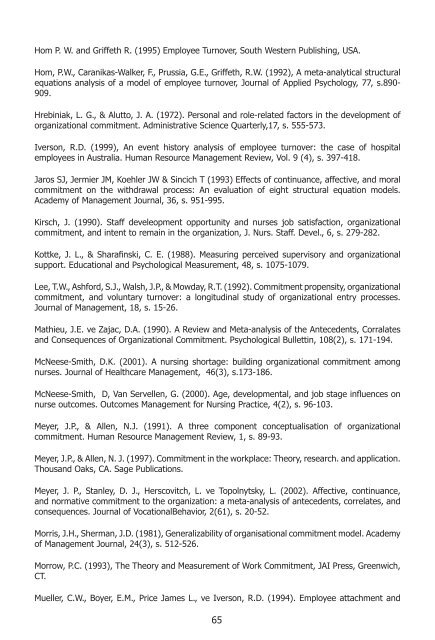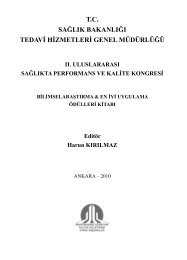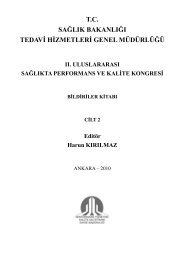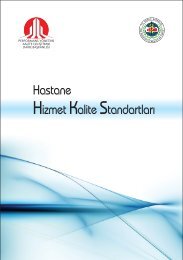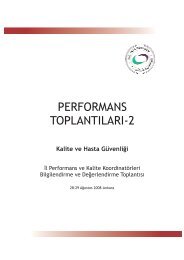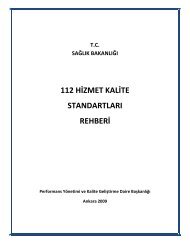- Page 1 and 2:
T. C. SAĞLIK BAKANLIĞI PERFORMANS
- Page 3 and 4:
KONGRE BAŞKANI Prof. Dr. Sabahatti
- Page 5 and 6:
SUNUŞ Değerli sağlık yöneticil
- Page 7:
ÖNSÖZ İnsan hayatının her aşa
- Page 10 and 11:
Mustafa Fedai Çavuş & Yeter Demir
- Page 12 and 13:
POSTER BİLDİRİLER ..............
- Page 14 and 15: SAĞLIK GRUP BAŞKANLARININ KALİTE
- Page 16 and 17: Dünyadaki sağlık sistemlerinin o
- Page 18 and 19: Şekil 2. Yöneticilik yıllarına
- Page 20 and 21: Türkiye’de sağlık hizmetlerind
- Page 22 and 23: Şekil 5. Sağlıkta Dönüşüm Pr
- Page 24 and 25: ulguları ile paraleldir. Sağlık
- Page 26 and 27: • Depolar • Mutfak • Çamaş
- Page 28 and 29: 2.7. Hasta Ve Çalışan Güvenliğ
- Page 30 and 31: Özet ANKARA İLİ KURUMSAL PERFORM
- Page 32 and 33: KAYNAKLAR Aslan Ş. Özata M. Ataye
- Page 34 and 35: Sağlıkta Dönüşüm Programı ka
- Page 36 and 37: ACİL ÜNİTESİ 2004 2007 ‣Kulla
- Page 38 and 39: AMELİYATHANE HİZMETLERH ZMETLERİ
- Page 40 and 41: SAĞLIK HİZMETLERİNDE DEĞİŞİM
- Page 42 and 43: Anketler karşılaştırılırken h
- Page 44 and 45: “Polikliniklerde aldığınız hi
- Page 46 and 47: %8,6, %29,5, %32,3 ve %27,5 iken Y.
- Page 48 and 49: 1. Poliklinik Hizmetleri 2. Laborat
- Page 50 and 51: hastanelerimizde bu hizmetlerin uyg
- Page 52 and 53: SAĞLIK KURULUŞLARINDA İNSAN KAYN
- Page 54 and 55: geliştirilmeye çalışılmıştı
- Page 56 and 57: İşten ayrılma eğilimi işten ay
- Page 58 and 59: 4. Bulgular memur statüsündedir.
- Page 60 and 61: 4.2.2. Örgütsel Bağlılık Boyut
- Page 62 and 63: Tablo 5. Örgütsel bağlılık boy
- Page 66 and 67: noncoercive conditions of work: The
- Page 68 and 69: In Turkey pulmonology specialist nu
- Page 70 and 71: 2. GÖĞÜS HASTALIKLARI UZMANLIK D
- Page 72 and 73: gerekli insan gücü planlaması ya
- Page 74 and 75: 2.3. Hedeflere Göre İnsangücü P
- Page 76 and 77: Transtorasik iğne aspirasyonu 12 2
- Page 78 and 79: PERFORMANS ARTIRMA YÖNTEMİ OLARAK
- Page 80 and 81: psikolojik bir yatırım” olarak
- Page 82 and 83: ilgi-maharet ve kabiliyetlerini hed
- Page 84 and 85: mevcuttur. Aynı zamanda genel pers
- Page 86 and 87: Sistemlerinin İncelenmesi: Örnek
- Page 88 and 89: Abstract The main purpose of invest
- Page 90 and 91: Şekil 1. Takım Oluşturma Süreci
- Page 92 and 93: alanı olarak ortaya çıkmasına n
- Page 94 and 95: göre (1998: 22); takım ve perform
- Page 96 and 97: Şekil 2. Normlara uygunluk ve bağ
- Page 98 and 99: Ankete katılanların %68.3’ü ka
- Page 100 and 101: şekilde işletmeye olan bağlılı
- Page 102 and 103: Takım üyelerinin birbirinden fark
- Page 104 and 105: Uygulamadan Örnekler, Yayınlanmam
- Page 106 and 107: We used the short form of “ICU Nu
- Page 108 and 109: • Sağlık çalışanlarının ar
- Page 110 and 111: Anketteki; • “Servisteki ileti
- Page 112 and 113: Tablo 2’de görüldüğü üzere
- Page 114 and 115:
yakınlarının ihtiyaçlarının k
- Page 116 and 117:
SAĞLIKLI İLETİŞİM VE İLETİŞ
- Page 118 and 119:
iletişimle ilgili olduğunu göste
- Page 120 and 121:
iletim becerilerinin öğretilmesi
- Page 122 and 123:
Tablo 5. Hekimler ilgili ve nazik m
- Page 124 and 125:
Tablo 12. Bir önceki dönem hemşi
- Page 126 and 127:
Tablo 18. Bir önceki dönem hekim
- Page 128 and 129:
Tablo 24. Sizinle ilgilenen sağlı
- Page 130 and 131:
Bir önceki dönem anket verilerine
- Page 132 and 133:
olacağı konusunda aynı düşünc
- Page 134 and 135:
HEKİMDIŞI SAĞLIK PERSONELİNİN
- Page 136 and 137:
• The rate of being pleased with
- Page 138 and 139:
4. BULGULAR Muğla Devlet Hastanesi
- Page 140 and 141:
Edition, McGraw-Hill, New York. Öz
- Page 142 and 143:
1. GİRİŞ Sağlık hizmetleri dok
- Page 144 and 145:
mecbur hissetmesi gibi bir durumdan
- Page 146 and 147:
2.3. Anket Uygulaması Anket doldur
- Page 148 and 149:
olduğu gibi hizmet yılı 11-16 y
- Page 150 and 151:
katılımı beyan etmişlerdir(%19
- Page 152 and 153:
Tüm Sorular(Eğitim Öncesi İçin
- Page 154 and 155:
edilse de eğitim sonrası bakış
- Page 156 and 157:
idari görevler sağlık çalışan
- Page 158 and 159:
DOKTOR UNVANLI BİR GRUP SAĞLIK Ç
- Page 160 and 161:
değerlendirilmesinde de bir takım
- Page 162 and 163:
uygulamaya dönük olumlu iyileşti
- Page 164 and 165:
Tablo 4. Hizmet ya da meslekteki te
- Page 166 and 167:
3.3. “Sağlık kurumları özelle
- Page 168 and 169:
azalış olmaması hatta yükseliş
- Page 170 and 171:
kurumlarda verimin elde edilmesi ve
- Page 172 and 173:
değişmesinde önemli bir potansiy
- Page 174 and 175:
Katılımı ölçülen ifadelerin b
- Page 176 and 177:
SAĞLIK SEKTÖRÜNDE PERFORMANS YÖ
- Page 178 and 179:
data source; position in the contin
- Page 180 and 181:
Donabedian’a göre, göstergeler
- Page 182 and 183:
Şekil 3. Sağlık kurumunun iç or
- Page 184 and 185:
1.4. Araştırmanın Amacı Bu ara
- Page 186 and 187:
Ardından Türkiye’de Sağlık Ba
- Page 188 and 189:
Tablo 2. Sağlık hizmetinin basama
- Page 190 and 191:
Tablo 4. Bireysel performans değer
- Page 192 and 193:
İncelenen çalışmalarda, sağlı
- Page 194 and 195:
Jones, Andrew M. (2006), The Elgar
- Page 196 and 197:
Abstract Growing power of human in
- Page 198 and 199:
etkilemekte ve kurumun görevlerini
- Page 200 and 201:
2.1. Performans Değerlendirmenin Y
- Page 202 and 203:
arası yaklaşımla ortaya konacakt
- Page 204 and 205:
Performans ölçüm alanlarından f
- Page 206 and 207:
Şekil 4. Kendi kendini yöneten ta
- Page 208 and 209:
Yapılan analizde görülen güçl
- Page 210 and 211:
Baş, Melih İ.- Artar, Ayhan. (199
- Page 212 and 213:
iletilmesi amacıyla Stratejik Yön
- Page 214 and 215:
2.2. Stratejik Analiz 2.2.1. Sağl
- Page 216 and 217:
17. 112 Acil S.H. Komuta Merkezleri
- Page 218 and 219:
22. Tütün Alkol Piyasası Düzenl
- Page 220 and 221:
• Türk Eczacılar Birliği vb. 2
- Page 222 and 223:
• Kamuoyundaki olumlu imaj, idare
- Page 224 and 225:
kullanımında uyum sorunu olması,
- Page 226 and 227:
2.3.4. Kritik Başarı Faktörleri
- Page 228 and 229:
2.3.5.2. Teşhis ve Tedavi Edici Sa
- Page 230 and 231:
KAYNAKLAR 224 Sayılı Sağlık Hiz
- Page 232 and 233:
BİR HASTANEDE STRATEJİK PLAN BAZL
- Page 234 and 235:
Strateji, belirli bir hedefe ulaşa
- Page 236 and 237:
2. STRATEJİK PLAN BAZLI SÜREÇ VE
- Page 238 and 239:
• Hizmet kalitesi için etkin ve
- Page 240 and 241:
• Sistematik Yaklaşım • Matri
- Page 242 and 243:
• Çalışma ilişkileri iyileşt
- Page 244 and 245:
mali durumu ve gelişimi ile ilgili
- Page 246 and 247:
• Bilimsel finansal yönetim uygu
- Page 248 and 249:
Şekil 2. VMSSS (CRISP-DM) metodolo
- Page 250 and 251:
Yukarıda sıralanan yöntemlerin h
- Page 252 and 253:
Kısa Vadeli Yabancı Kaynaklar / K
- Page 254 and 255:
4.3. CHAID Karar Ağaçları Algori
- Page 256 and 257:
etkilediğini göstermektedir. Sist
- Page 258 and 259:
5. SONUÇ VE ÖNERİLER Ülkemizdek
- Page 260 and 261:
in The Analysis Of Unimodal Respons
- Page 262 and 263:
HASTANELERDE DIŞ KAYNAK KULLANIMI
- Page 264 and 265:
1.1. Dış Kaynak Kullanımı Kavra
- Page 266 and 267:
• Kontrol maliyetleri ve tedarik
- Page 268 and 269:
3. KOCAELİ İLİNDEKİ HASTANELERD
- Page 270 and 271:
3. 2. 2. Hastanelerin DKK Durumu Ta
- Page 272 and 273:
Araştırma sonucunda; Dış kaynak
- Page 274 and 275:
Araştırmaya katılan hastanelerde
- Page 276 and 277:
SAĞLIK HİZMETLERİNDE YEREL YÖNE
- Page 278 and 279:
2. SAĞLIK HİZMETLERİ Dünya Sağ
- Page 280 and 281:
Tablo 1. Sağlık Bakanlığı büt
- Page 282 and 283:
toplantı sonucunda yayınlanan “
- Page 284 and 285:
Şekil 3. Belediyelerde sağlık hi
- Page 286 and 287:
istihdam, tıbbi rehabilitasyon hiz
- Page 288 and 289:
Tablo 8. Denetim ve kontrol hizmetl
- Page 290 and 291:
6. SONUÇ Yerel yönetimlerin sağl
- Page 292 and 293:
Conference, New York, 19 June - 22
- Page 294 and 295:
BİRİNCİ BASAMAK SAĞLIK KURULUŞ
- Page 296 and 297:
ekonomik durum ve uzmanlık beklent
- Page 298 and 299:
2.2. Araştırma Yöntemi ve Veri T
- Page 300 and 301:
Tablo 3. Performansa dayalı döner
- Page 302 and 303:
Birinci Basamak Sağlık Hizmetleri
- Page 304 and 305:
hospitals should be clearly investi
- Page 306 and 307:
2. Veri Zarflama Analizi Yönetimi
- Page 308 and 309:
Tablo 1. Çalışmada kullanılan g
- Page 310 and 311:
ulundurulduğunda o hastanenin tekn
- Page 312 and 313:
verilerin bulunmayışı devlet ve
- Page 314 and 315:
Chu H. L., Liu S. Z., Romeis J. C.,
- Page 316 and 317:
This study determined that the effe
- Page 318 and 319:
unsurları performans anlayışın
- Page 320 and 321:
Grafik 2. Yıllara göre uzman heki
- Page 322 and 323:
yılında ise %9 oranında bir art
- Page 324 and 325:
Grafik 10. Yıllara göre ortalama
- Page 326 and 327:
4. SONUÇ Mesleği serbest icra etm
- Page 328 and 329:
analizi ile 2003-2008 yılları ara
- Page 330 and 331:
Soru 5. Sizinle ilgilenen personel
- Page 332 and 333:
4.2. Yatan Hasta Memnuniyeti Anketl
- Page 334 and 335:
Hemşirelerin ilgi ve nezaketinden
- Page 336 and 337:
Soru 4. hastanemizde yürütülen h
- Page 338 and 339:
Soru 10. Hastanemizin aldığı kal
- Page 340 and 341:
4.10. Gelir Gider Oranları 5. TART
- Page 342 and 343:
than so often. Although the monthly
- Page 344 and 345:
3. BULGULAR 2006 ve 2007 yılların
- Page 346 and 347:
sonuçlar üzerine etki eden bir fa
- Page 348 and 349:
Tablo 4. Dört hastanemizin gelirle
- Page 350 and 351:
PERFORMANSA DAYALI EK ÖDEME SİSTE
- Page 352 and 353:
Performansa Dayalı Ek Ödeme Siste
- Page 354 and 355:
aşamalarını içeren bir süreçt
- Page 356 and 357:
Şekil 1. Yapay sinir ağları yap
- Page 358 and 359:
3.1. Bulanık Etiketleme Modülü (
- Page 360 and 361:
Şekil 6. Yapay sinir ağı tabanl
- Page 362 and 363:
yalnızca uzmanların yaptığı, d
- Page 364 and 365:
healthcare, cost reduction, increas
- Page 366 and 367:
yapıya sahip olduğu ifade edilebi
- Page 368 and 369:
2002 yılı baz alınarak yapılan
- Page 370 and 371:
Tablo 5. 2002-2007 yılı döner se
- Page 372 and 373:
eşitsizliklerin ortadan kaldırıl
- Page 374 and 375:
POSTER BİLDİRİLER 374
- Page 376 and 377:
during 10 February - 10 April 2007.
- Page 378 and 379:
3.BULGULAR Tablo 1. Öğrencilerin
- Page 380 and 381:
YAŞ GRUPLARI ADET SONRASI DÖNEM N
- Page 382 and 383:
SAĞLIK KURUMLARINDA HİZMETLERİN
- Page 384 and 385:
Hastanelerde pazarlama faaliyetleri
- Page 386 and 387:
3.3. Bulgular Araştırmaya katıla
- Page 388 and 389:
Ergeç E., N., (2004), Televizyon R
- Page 390 and 391:
1. GİRİŞ 1.1. Amaç Hastanemiz 7
- Page 392 and 393:
Tablo 1. Poliklinik başvuruları P
- Page 394 and 395:
Grafik 5. Polikliniklerden hasta ya
- Page 396 and 397:
Sonuç olarak; aile hekimlerinden y
- Page 398 and 399:
obviously investigated. This study
- Page 400 and 401:
Max J ∑ j = 1 I ∑ i= 1 v u y m
- Page 402 and 403:
3.2. Hastane Bütçesi Tüm organiz
- Page 404 and 405:
ulaşılmıştır. Bu durum Sağlı
- Page 406 and 407:
hastanelerindeki pratisyen doktor s
- Page 408 and 409:
pp. 229-235 Charnes A., Cooper W. W
- Page 410 and 411:
en önemli araçlarından biridir (
- Page 412 and 413:
Hekimler, hemşireler, tedavi ve ba
- Page 414 and 415:
HİZMET KALİTE STANDARTLARI VE KAL
- Page 416 and 417:
Ayrıca kurumun misyon ve vizyonun
- Page 418 and 419:
Yönetim Becerilerinin Geliştirilm
- Page 420 and 421:
ULUSLARARASI HASTA GÜVENLİK HEDEF
- Page 422 and 423:
2.2. Etkin İletişimin Geliştiril
- Page 424 and 425:
Bu amaçla “Hasta Düşmelerini
- Page 426 and 427:
glucose challenge tests are advised
- Page 428 and 429:
KAYNAKLAR Bütçe Uygulama Talimat
- Page 430 and 431:
1. GİRİŞ Sağlık hizmeti sunan
- Page 432 and 433:
Tablo 2. Personelin yönetim ve kur
- Page 434 and 435:
ve öneri getirme konusunda sıkın
- Page 436 and 437:
436


